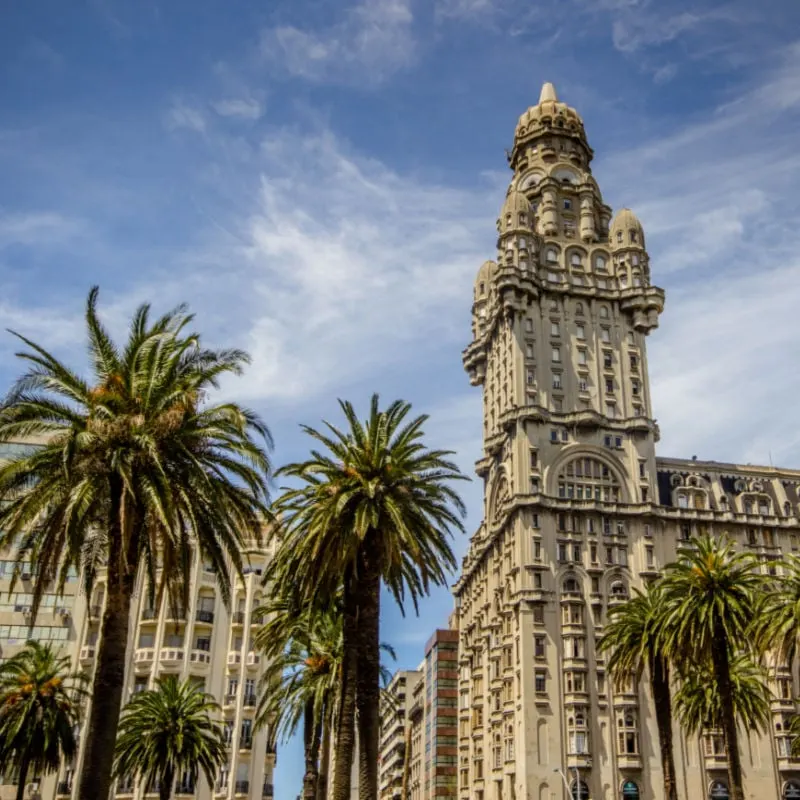Travel Guide
South America’s Next Digital Nomad Hotspot Unveiled
Last Updated
It’s no surprise digital nomads have been flocking to Latin America lately.
Be it the warm hospitality of locals, the vibrant Hispanic culture, or the tax exemptions, they often find life down south is far more pleasant and carefree.
For those very same reasons, places like Mexico City, Rio and Buenos Aires have skyrocketed in popularity with digital nomads in recent years:
From the beautiful beaches of Yucatan all the way to the Belle époque boulevards of Buenos Aires, Latin American hotspots are teeming with cafegoers working in online businesses, but one underrated spot that has largely flown under the radar––up until now––is Montevideo:


Why Is Montevideo Becoming So Popular All Of A Sudden?
The capital city of Uruguay, a tiny country nestled between the much-larger Brazil and Argentina, it is historic port city over 1.3 million people call home, among those a growing number of workcationers: it is the seventh-best destination worldwide for digital nomads, according to VisaGuide.
The ranking takes into account a variety of factors, including active visa availability––how easy it is for nomads to settle in Uruguay––internet speed, the taxation policy affecting foreigners, and the cost of living.
Though it’s not nearly as popular as other Latin American metropolises, Montevideo excels in most categories:


It Has Reliable Internet And Cozy Cafes
Having a reliable, stable internet connection is paramount for nomads when picking their next destination.
As beautiful as it may be, working remotely from the Colombian or Ecuadorian jungle can be challenging if you’re intent on not missing important Skype calls or responding to emails on time.
Lucky for nomads, internet speed in Uruguay, and especially urban areas like Montevideo, is pretty fast, averaging 156.75 megabits per second, while the world average is only 42.35, placing it 26th worldwide on the Speedtest Global Index.


There’s also no shortage of laptop-friendly eateries and coworking spots in Montevideo, from the cozy Gold Of The Rhine Cafe, found at the back of a bookshop overlooking the bay, to the bougie Lab Coffee in Punta Carretas, with its high-quality coffee and timeless vintage decor.
If you’re looking for a bite to eat as you get some work done, Flora is the perfect brunch spot, serving French toast and delicious pancakes.
As for an alfresco cafe experience, we can warmly recommend Cafe del Jardin, where the service is as excellent as the smoothies.
Montevideo Has A Thriving Nomad Scene


Moving abroad, however temporarily, is scary enough as it is.
Settling in can be quite challenging, especially if it’s a culture and language different than you’re own, and making friends can take effort and time (even in South America).
Though some would prefer to keep it undiscovered for longer, a higher concentration of workcationers around usually means foreigner-friendly services, as local businesses and authorities alike become more used to an international clientele and a greater sense of community.


We already see signs Montevideo is becoming a powerful digital nomad hub, from the relaxation of visa policies, which we’ll touch on in the next section, to the recent influx of remote workers: last year, 2,614 nomads chose it as a destination, as Resume.io reports.
There’s no doubt Montevideo is growing fast in popularity with nomads, and a solid indication of that is its ranking on Nomad List: it’s currently the third highest-charting city in the Latin category, behind only Buenos Aires and trendy Mexico City.


If you’re looking to socialize, the Shannon Irish Pub, La Cretina and Bar Rodó are three great spots for meeting and socializing with locals (as well as fellow expats)––and beer is remarkably cheap, with a pint of local beer going for just $3.46 in some bars.
Getting A Visa Isn’t Hard At All
Thriving cafe culture and nomad scene aside, you’re not required to pay income tax to set up a residence as a digital nomad in Montevideo.
This is because in Uruguay, the exportation of digital services, which typically applies to most remote workers, is exempt of taxation, as noted by Live in Uruguay.


This applies to foreigners who have obtained a Uruguayan Digital Nomad Visa, or those who are visiting on a short-term tourist visa only: if you’ve relocated to Uruguay under a different category, the exemption may not apply and we’d advise you instead to seek counseling from the local tax office.
As Travel Off Path reported previously, Uruguay is one of the easiest countries to obtain a digital nomad visa, as there are no fixed income requirements, and nomads don’t need to apply in advance: they can do so from Uruguay.


You’re pretty much free to enter the country as a tourist, especially if you’re a U.S. passport holder, and before the three months are up, you should apply for an ‘Hojas de Identidad Provisoria‘, the Uruguayan equivalent to a temporary residence permit.
You’ll need to present a number of documents, such as a valid passport and a signed affidavit confirming you can support yourself during your prolonged stay in Montevideo, but nothing out of the ordinary.
It Is Cheaper To Live In Than Most Of The U.S.


Coupled with the attractive tax policy, the overall affordability of Montevideo as a destination makes it incredibly attractive to digital nomads.
As Numbeo estimates show, a meal in an inexpensive restaurant in Montevideo can cost as cheap as UYU $546.00, or USD $13.60, while a more elaborate, three-course dinner in a chic downtown restaurant will set you back an acceptable $49.44 (for two people).
Rent-wise, a one-bedroom apartment in the city center costs on average USD $590, while a three-bedroom apartment is roughly USD $1,011 monthly: these estimates are in line with Airbnb prices in Montevideo, which range from $517 to $1,110.


Naturally, prices can fluctuate depending on season, but overall, nomads expect to spend $2,722 monthly living in Montevideo, according to Nomad List: not the cheapest destination in South America, but reasonably affordable nonetheless.
The One Aspect Montevideo Doesn’t Excel At
Then, there’s the matter of security:
Sure, Montevideo is no Bern, Switzerland or Reykjavik, Iceland, but in the context of Latin America, it is one of the least dangerous capitals, with a crime index of 55.93, as reported again by Numbeo: for comparison purposes, Rio’s crime index is a much-higher 77.56 in the same ranking.


In general, nomads shouldn’t be overly worried about violence when walking the streets of Montevideo, but they must still keep their wits about them: in other words, dress modestly, leave their valuables at home, and watch where they go.
The U.S. Department of State echoes this advice, classifying Uruguay as a Level 2 destination. This means Americans are not discouraged from visiting, and nomads are definitely not advised against moving there, but they must exercise caution in certain scenarios.


As is the case with any major city in South America, avoid using your phone in public, particularly if it’s an expensive one, don’t wear jewelry unless you’re in a safe environment, such as a hotel or restaurant, and beware of pickpockets and criminals.
The State Department also mentions criminals traveling in pairs on motorcycles, who usually approach victims with a weapon and demand that they surrender their valuables; staying vigilant and avoiding deserted streets can help with lowering the risk of assault.


That being said, a majority of digital nomads feel safe in Montevideo, as attested by Nomad List, where the city has scored an ‘okay’ rate in both Safety and Lack of Crime.
Underrated Cultural Gem Awaiting Discovery
Finally, Montevideo is a cultural jewel we have all been sleeping on for so, so long.
The likes of Rio, with its glitzy Copacabana beachfront, or Buenos Aires, the Paris of the South certainly need no introduction, but what of Montevideo and its underrated cultural gems?
The Spanish-built Historic Center of Montevideo is everything you’d expect of a Spanish-built city in the New World, with the monumental square flanked by palatial buildings and charming backstreets flanked by colonial mansions.


The most striking building in town, Palacio Salvo is a 20th-century marvel designed by Mario Palanti, an Italian migrant who did his best to import the ornate architecture of his home continent (with an eclectic twist).
A short 8-minute walk away, the Metropolitan Cathedral is not to be missed, either, nor the remnants of the once heavily fortified citadel. Now here’s something really cool:
In case you didn’t know, the Uruguayan capital was surrounded by walls back in the day, like a good European colony, to protect it from assailants––pirates weren’t a phenomenon exclusive to the Caribbean only.


They would eventually tumble, and the citadel destroyed upon the invasion of the British in 1807, but some of the streets where the wall used to run still recall its existence, such as Ciudadela––where a surviving remnant of the wall stands––and Brecha, or ‘breach’.
Yep, the exact spot where the British penetrated the fortification.
Other than soaking up the History, nomads can find local produce at Mercado Agricola, one of the city’s most traditional, eat at a casual restaurant in the grand 19th-century mess hall that is Mercado del Puerto, or spend their evening watching an opera at the neoclassical Solis Theater.
Montevideo is a city of endless possibilities, and there’s no doubt you’ll have the time of your life working remotely from here (and exploring).
↓ Elevate Your Travel↓
Sign Up Now For Travel Off Path Premium! No ads, VIP Content, Personal Travel Concierge, Huge Savings, Daily Deals, Members Forum & More!


✈️Join Our Travel Off Path Community Forum: Where travelers unite, ask questions, share experiences and even find like-minded travel buddies!
SUBSCRIBE TO OUR LATEST POSTS
Enter your email address to subscribe to Travel Off Path’s latest breaking travel news, straight to your inbox.
This article originally appeared on TravelOffPath.com
Opinions expressed here are the author’s alone, not those of any bank, credit card issuer, hotel, airline, or other entity. This content has not been reviewed, approved or otherwise endorsed by any of the entities included within the post.

